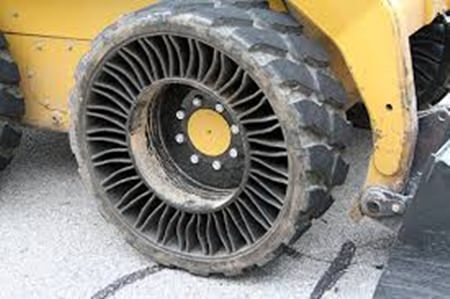One of the topics in Facebook recently has been an airless wheel, which many think is a new development. Sorry to say that it is not.
About 10 years ago I featured the Tweel (tyre and wheel), a product of Michelin’s research. It looked as if Michelin had scored a huge technological breakthrough. “Major revolutions in mobility may come along only once in a hundred years,” said Terry Gettys, president of Michelin Americas Research and Development Center. “But a new century has dawned and Tweel has proven its potential to transform mobility. Tweel enables us to reach levels of performance that quite simply aren’t possible with today’s conventional pneumatic technology.”
That was 10 years ago, and despite Tweel winning all sorts of awards, it isn’t on production cars yet. Michelin claimed its “Tweel” has load carrying, shock absorbing, and handling characteristics that compare favorably to conventional pneumatic tires; however, the tyre has a lot of vibration when driving over 80 km/h. In addition, higher rolling resistance was found and provide much less suspension than similarly shaped and sized pneumatic tires. Other problems for airless tires include dissipating the heat buildup that occurs when they are driven.
 Michelin Tweel.
Michelin Tweel.
Lynn Mann, a spokeswoman for Michelin’s North American headquarters said the company has developed airless tire prototypes for the military but has no contracts to provide them. Michelin is concentrating efforts on low-speed, low-weight uses of an airless tire on construction equipment first.
“We are years away from having a passenger car application,” Mann said. “We do have a very early prototype for a passenger car. When you get it up to a high speed, 80 or 100 kph, there is noticeable noise. We need to solve the noise issue.”
Others have begun their own research into airless tyre/wheel technology, and one such group has been making further inroads towards commercial reality.
One new group is called Resilient Technologies LLC and is based in Wisconsin, USA, which is working on a US$18 million project with the US DoD (Department of Defense) and the University of Wisconsin-Madison to research and develop a non-pneumatic tyre for use on heavy-grade military vehicles such as Humvees.
Tyres have proven to be the weak link in military Humvees, which can be immobilized by the scourge of the 21st century urban battlefield, the IED (Improvised Explosive Device). Once the mobility of a vehicle is compromised in a hostile environment, its inhabitants’ life expectancy closely approximates zero. There have been numerous cases of this in Iraq, for example.
As neither Michelin’s Tweel nor Resilient’s Airless tyre have a tyre-like pressurized air cavity, they cannot be punctured, thus assuring continuous mobility.
Resilient has been developing their airless tyre over the past two years, starting with production models for lawn tractors and now to full-size Humvee applications.
The Resilient design relies on a precise pattern of hexagonal cells that are arranged, like a honeycomb, in a way that best mimics the ‘ride feel’ of ordinary pneumatic tyres. The honeycomb geometry also does a great job of reducing noise levels and reducing heat generated during usage – two common problems with past applications.
Further projects will include evaluating sidewall designs, which will give the tyre a more conventional look.
As part of that development, Resilient performs a static load test to meet the Army’s requirement that it be able to handle a maximum load of 1,746 kilograms.
Will there be a civilian application after the military one? I would suggest that you will see this within five years – but will the price be competitive? In theory, these tyres could be cheaper to produce than the current laminated carcass tyre. An interesting thought. However, remember where you replaced a tyre when the tread was too shallow, with these airless wheels you replace the tread and the wheel.




